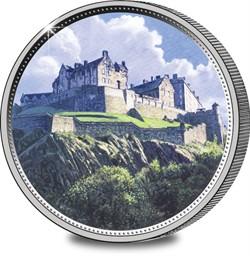-no-button.jpg)
 |
Location: Castle Rock, Edinburgh,
Scotland
Date completed: 12th Century
Designer/Builder: Possibly King David I of
Scotland; subsequently rebuilt
Function: Defensive Stronghold and royal
residence
|
Edinburgh is an historic city with many fine buildings and
outstanding features. But inevitably the eye is drawn to the
towering presence of Edinburgh Castle, dominating the skyline from
its position atop the Castle Rock, the plug of an extinct volcano.
The origins of the Castle are lost in the mists of time. There is
some evidence of occupation in the Iron Age and possibly Bronze
Age. We know that King David I occupied a royal castle on the site
in the 12th century and it was used as a royal residence until the
Union of the Crowns in 1603, when James VI (1566-1625) became James
I of England. James was born to Mary Queen of Scots in the Castle.
In 1571 the "Lang Siege" (a struggle between rival Scots factions,
with English intervention) resulted in much of the Castle being
destroyed. The 12th Century Chapel of St Margaret survived, and is
today the oldest building in Edinburgh. The Lang Siege was just one
of many conflicts centred on the castle. In the 14th century wars
of Scottish independence, the invading English army occupied the
Castle. In 1314 Thomas Randolph led a band of scot warriors in an
audacious night raid and succeeded in recapturing the Castle. In
1745 the great-great-great-grandson of Mary Queen of Scots, Charles
Edward Stuart - "Bonnie Prince Charlie" - captured Edinburgh during
the Jacobite rebellion but failed to take the Castle.
Today the Castle is the most visited paid-for tourist attraction
in Scotland, with 1.2 million visitors a year. As well as the
historic buildings of the Castle, they can visit the National War
Museum of Scotland as well as several regimental museums. In 1296
Edward I invaded Scotland and removed the "Stone of Destiny" (or
"Stone of Scone") on which Scottish kings had been crowned for
centuries from the Castle. He took it to London, where it was
placed beneath the Coronation throne. In 1996 it was returned to
Scotland and is now displayed in the Crown Room. The Castle also
contains the Scottish Regalia, known as "the honours of Scotland"
and is the venue for the world famous Edinburgh Military
Tattoo.